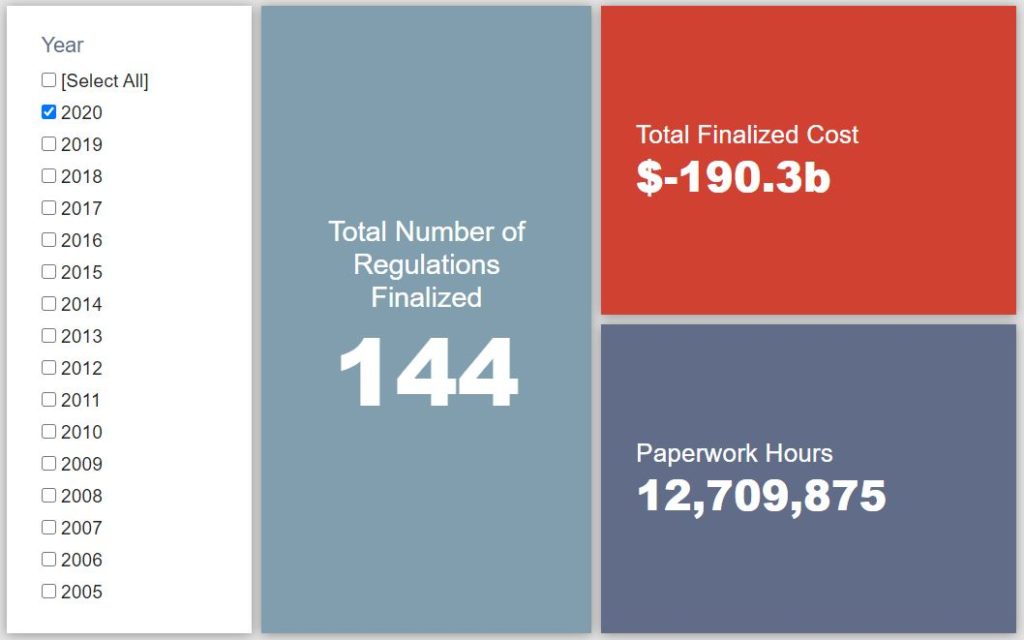Week in Regulation
June 1, 2020
DOL Technology Changes Headline Deregulatory Week
Last week came out on the net-deregulatory side yet again. Most of the cost savings, however, came from a single Department of Labor (DOL) rule regarding the electronic disclosure of retirement plan information under the Employee Retirement Income Security Act of 1974 (ERISA). Additionally, a DOL sub-agency made a subtle change to the release of key employment data also spurred in part by a new technological landscape. Across all rulemakings, agencies published $4.9 billion in total net cost savings but added 235,039 hours of annual paperwork.
REGULATORY TOPLINES
- Proposed Rules: 28
- Final Rules: 42
- 2020 Total Pages: 32,933
- 2020 Final Rule Costs: -$190.3 billion
- 2020 Proposed Rule Costs: $8.3 billion
TRACKING THE REGULATORY BUDGET
Last week’s most significant action regarding the fiscal year (FY) 2020 regulatory budget under Executive Order (EO) 13,771 was DOL’s rule on “Default Electronic Disclosure by Employee Pension Benefit Plans Under ERISA.” The rule establishes a safe harbor for plan administrators to provide such disclosures electronically as a default with an opt-in for paper-based disclosures. This basically flips around the traditional framework that defaulted to paper-based while allowing limited electronic options. DOL estimates that “by reducing the production and mailing costs associated with paper disclosures,” this rule could save $319 million annually, or roughly $4.6 billion in present value.
The Trump Administration expected to reach $51.6 billion in cumulative net savings in FY 2020. To date in the fiscal year, agencies have officially published 88 deregulatory actions and 30 regulatory actions, totaling $191.5 billion in quantified total net cost savings.
THIS WEEK’S REGULATORY PICTURE
This week, the Bureau of Labor Statistics (BLS) pulls the plug on giving media early access to key economic data.
In a notice published in the May 27 edition of the Federal Register, the BLS, an agency within the DOL, announced that it would permanently discontinue the use of its “lock-up facility,” a room where credentialed media could review economic data such as the weekly unemployment claims and monthly employment situation reports for 30 minutes prior to public release.
As the BLS notice explains, the facility was created in the mid-1980s as a way allow the media to digest the information before its public release so it could formulate accurate analysis of the data. The need for this has diminished over time as the Internet has allowed the information to be disseminated to anyone interested at the same time. In addition, DOL’s inspector general has recommended reforms to the facility since media has marketed its access as a competitive advantage for paying customers, such as high-frequency traders, to get ahead of market reactions to the news. The image below is cited by BLS as such marketing.

Image accessed at https://www.ap.org/discover/event-driven-data on May 27, 2020.
Earlier this year, BLS announced it would no longer allow electronic devices in the facility as of March 1, 2020, to help prevent priority paid access to information. BLS eventually was forced to close the facility altogether because of COVID-19. Since that time, BLS says, the media has shown it can effectively communicate the data of key economic reports without its embargoed access. In addition, closing the facility will allow BLS to meet the DOL inspector general’s recommendation to reform how early access to data is used by the media. For these reasons, BLS will permanently close the lock-up facility on June 3.
TOTAL BURDENS
Since January 1, the federal government has published $182 billion in total net cost savings (with $190.3 billion from finalized rules) and 29.6 million hours of net annual paperwork burden increases (with 12.7 million hours due to final rules). Click here for the latest Reg Rodeo findings.












